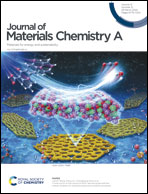Synergy of Cu-foam/Sb2O3/rGO for stable potassium anodes of high-rate and low-temperature potassium metal batteries†
Abstract
Potassium (K) with higher abundance than lithium has been explored as an anode material for K metal batteries (KMBs) for possible application in large-scale energy storage. However, the unstable solid electrolyte interface (SEI) at the K anode due to uncontrolled growth of K dendrites is a challenge in KMB development. In this paper, a multifunctional interface containing Sb2O3 and reduced graphene oxide (rGO) on Cu foam to form a current collector (Cu@Sb2O3@rGO) is developed for a KMB anode through structural regulation, where the Cu form with a large surface area can reduce the volume change during charge and discharge processes, Sb2O3 can provide potassiophilicity toward uniform K plating and stripping to give a dendrite-free K anode, and rGO can provide abundant defects for increasing the ion transport and reaction kinetics. Such a Cu@Sb2O3@rGO current collector exhibits a remarkable reversibility of K plating/stripping for up to 600 cycles at 0.5 mA cm−2/2 mA h cm−2, and the formed Cu@Sb2O3@rGO@K anode demonstrates an extended cycle lifespan of 1300 hours under 0.2 mA cm−2/0.2 mA h cm−2 in symmetric cells. This anode-constructed PTCDA‖ Cu@Sb2O3@rGO@K full battery exhibits both exceptional cycling stability (over 2000 cycles) and outstanding rate capability (112.8 mA h g−1 at 10 C). Furthermore, even under extremely low temperature (−20 °C), this battery can still maintain an impressive 55% of its room temperature capacity. In situ Raman spectroscopic techniques and electrochemical methods including in situ EIS, half cell, symmetric cell, and full cell tests and theoretical DFT calculations are carried out to probe the structure–performance relationship and the reaction mechanisms for fundamental understanding toward further optimizing the performance of such the K anode and the corresponding KMBs. The strategy for stabilizing the K metal anode in this work may provide a guidance for further development of advanced low-temperature potassium metal batteries.

- This article is part of the themed collection: 2024 Journal of Materials Chemistry A HOT Papers


 Please wait while we load your content...
Please wait while we load your content...